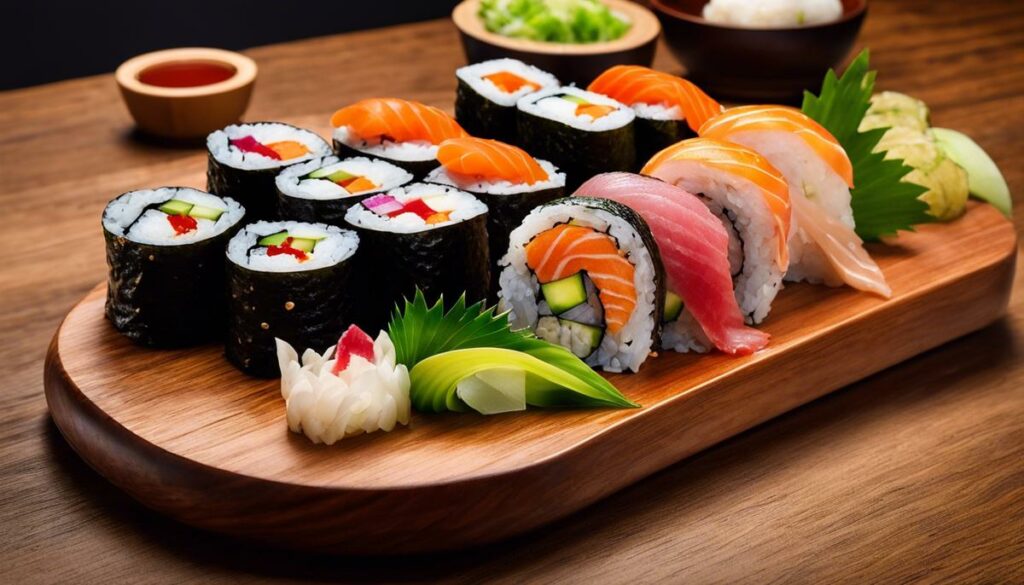At the heart of Japan’s culinary scene, sushi is a dish revered for both its understated elegance and its pungent flavor complexity. A perfect symbiosis of rice, fish and other ingredients such as crab meat, for many sushi is much more than just a dish – it is an art form. But how did sushi come into the world and what made it what it is today? In this essay, we’ll take a deep dive into the history, variety, and role of crab meat in sushi, while also exploring questions about the health and sustainability of this popular dish, as well as providing tips on how to get creative with sushi recipes. Prepare yourself for a journey through the exciting world of sushi by keeping an eye on every roll, bite, and detail.
The History of Sushi
Title: A Journey Through Time: The Impressive Evolution of Sushi
It’s no secret that sushi has become synonymous with refined flavor and cultural sophistication in the modern world. However, this delicious Japanese dish has a history that spans centuries. How exactly has sushi evolved over time?
Sushi’s roots date back to the 4th century in Southeast Asia, where it was originally used as a method of preserving fish. The fish was wrapped in fermented rice, which was later discarded. This is a far cry from today’s practice, where the rice itself often serves as the main actor on the plate.
Over time and with the advancement of refrigeration technologies, the preparation of sushi changed dramatically. A form of “fast sushi” developed, using vinegar rice to mimic the taste of fermented rice while keeping the fish fresh.
However, until the 19th century, sushi was mainly sold to take away and not served in restaurants. This “fast-food” twist on sushi, known as edomae sushi, was eye-catching and colorful, contributing to its growing popularity.
The 20th century brought a host of innovations, including the invention of the California roll in the 1960s, which put sushi on the map around the world. This “Americanized” style of sushi made the enjoyment of sushi even more accessible and took the dish to a whole new level of global recognition.
Today, sushi is more diverse and creative than ever. From spicy squid rolls to sweet sushi desserts, the possibilities are truly endless. There’s no question that sushi has earned its status as a culinary work of art due to its ability to constantly evolve and adapt.
Although sushi has changed a lot over the centuries, one aspect remains the same: its undeniable sense of elegance and aesthetics. This food culture manages to be both traditional and innovative at the same time, making it an exciting metaphor for the aesthetic diversity of life itself. It’s no wonder that sushi remains a favorite among foodies and fashion-conscious people from all over the world.
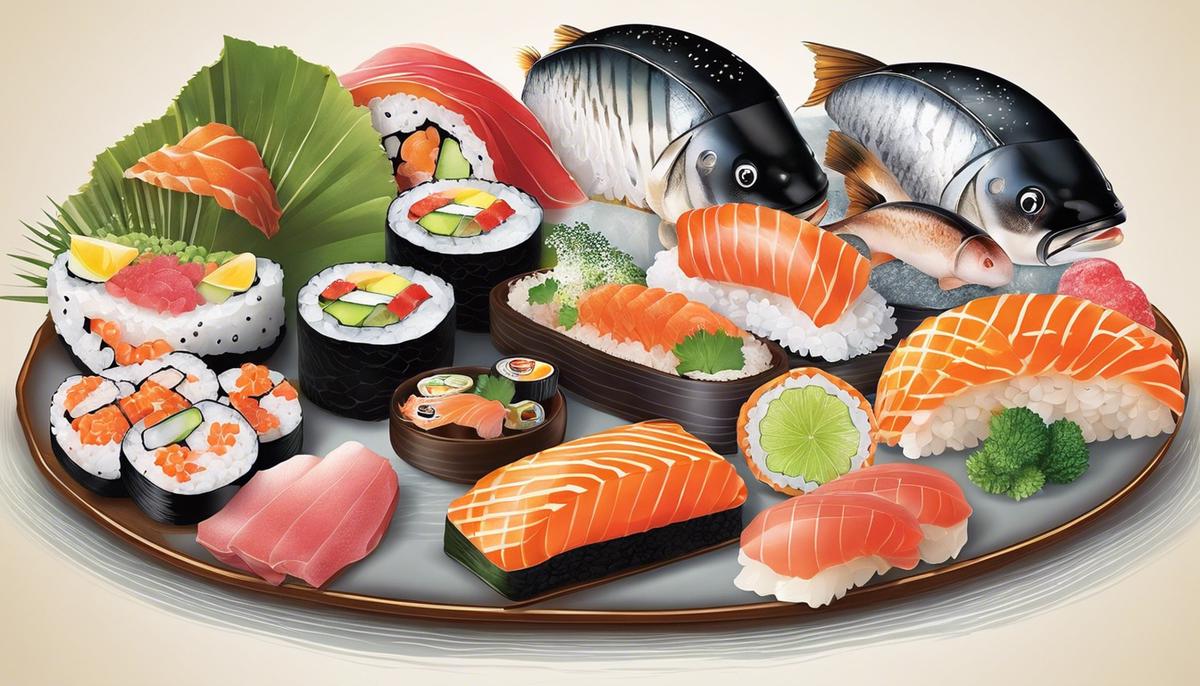
The variety of sushi
Sushi – it’s far more than just raw fish on a portion of rice. It is a culinary symphony that has conquered not only Japan but also the globe in its incredible variety of variations and interpretations. From traditional styles to state-of-the-art creations, the culinary world of sushi continues to blossom. One thing is certain: in the world of sushi there are no boundaries or right or wrong, what counts is the harmonious taste and attention to detail.
Elegance and aesthetics are firmly anchored in sushi’s DNA; they are evident not only in the artful execution of the sushi masters, but also in the presentation of every single bite. Like fashion, sushi captures the essence of the here and now and translates it into the simple, yet complex play of textures and flavors.
Since sushi culture relies on creativity and innovation, we are constantly seeing new creative variations. A good example is the ‘Vegan Sushi’. Fish and seafood are replaced by fresh, seasonal plant-based ingredients. From marinated tofu to avocado and grilled peppers, only your creativity is the limit for this green revolution in the sushi world.
Fusion sushi has also established itself as a popular trend, as it combines a wide variety of culinary traditions and creates something completely new. Imagine, for example, sushi filled with cheddar cheese and BBQ beef – this is a taste experience that sushi, barbecue and cheese lovers alike.
Finally, a small but fine trend in the sushi world: ‘dessert sushi’. Instead of fish and vegetables, the vinegar-flavored sushi rice is filled with a variety of sweet ingredients such as fresh fruits, chocolate, and even ice cream. A perfect finishing touch to any sushi menu or a fun and top-notch variation for all those with a sweet tooth out there.
Sushi – it’s a culinary act of balance, where simple ingredients work with complex flavors and textures to create unexpected delicacies. With so much room for creativity and experimentation, it’s no wonder the world has fallen in love with this particular art form of gastronomy. Just the idea of what might come next makes your mouth water!
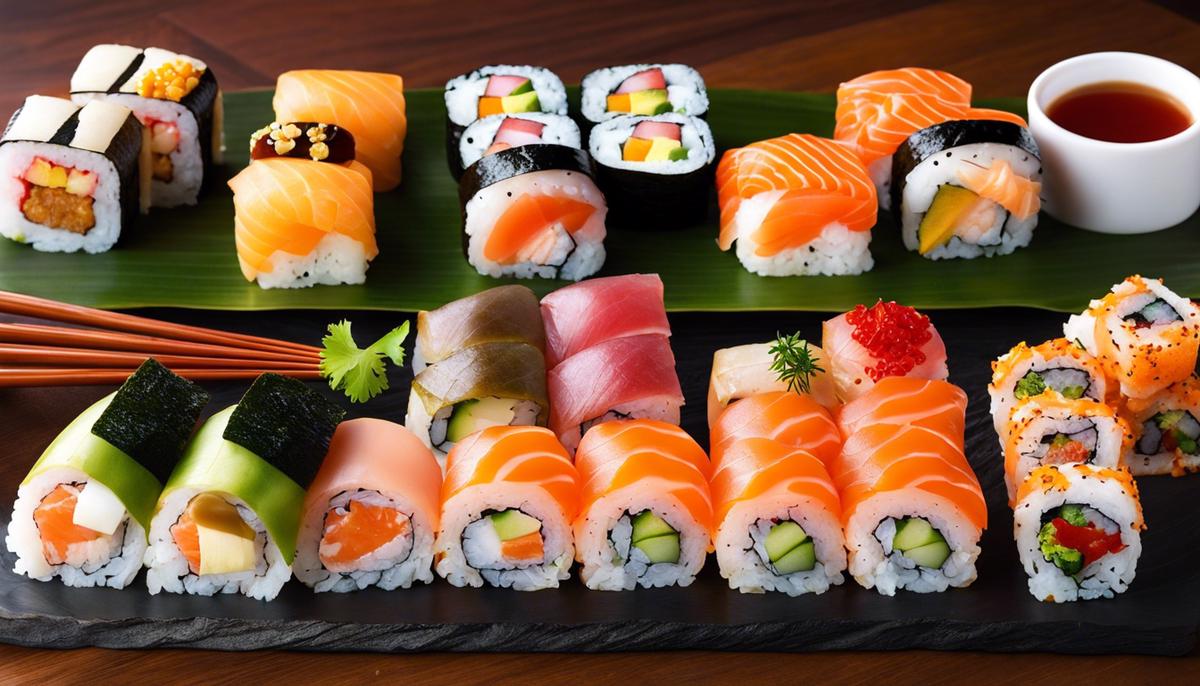
The role of crab meat in sushi
Another element that has made sushi a global phenomenon is crab meat. In the U.S., we can trace the rise of crab meat back to the invention of the California roll, but it has since spread throughout the sushi world and is now always in the spotlight due to its unique texture and delicate taste.
A major factor that makes crab meat the ideal ingredient for sushi is its versatility. It pairs perfectly with a variety of side dishes, from crunchy veggies to creamy avocado, while bringing out the mild flavor and cool texture of sushi. In addition, crab meat is nutritious but low in caloric content – a win-win situation.
Aesthetics also play an important role. Crab meat brings a delightful play of color to any sushi creation, especially when used as a topping for nigiri sushi – the red hue of the crab meat contrasts beautifully with the pure white of the sushi rice and the dark color of the seaweed.
Likewise, the trend of fusion sushi ensures that crab meat is in the spotlight. Crab meat can be found in sushi creations inspired by other cuisines, such as Mexican sushi burritos or Korean kimbap rolls.
Not to mention the green revolution in the sushi world – Vegan Sushi. Here, the focus is on “vegan crab meat”, which is made from heart-shaped palm kernels. The idea of finding sustainable and animal-friendly alternatives is revolutionary and driving the sushi world forward.
Last but not least, crab meat creates the perfect balancing act between simple ingredients and complex flavors. Although it has its own unique texture and flavor, it can complete and stimulate the flavor and aroma of the other ingredients without overshadowing them. Therefore, it is an outstanding ingredient that is delicate and robust at the same time.
In summary, crab meat is more than just an ingredient for sushi, it’s a reflection of modern-day sushi culture, which is constantly evolving to embrace new flavors and ideas.
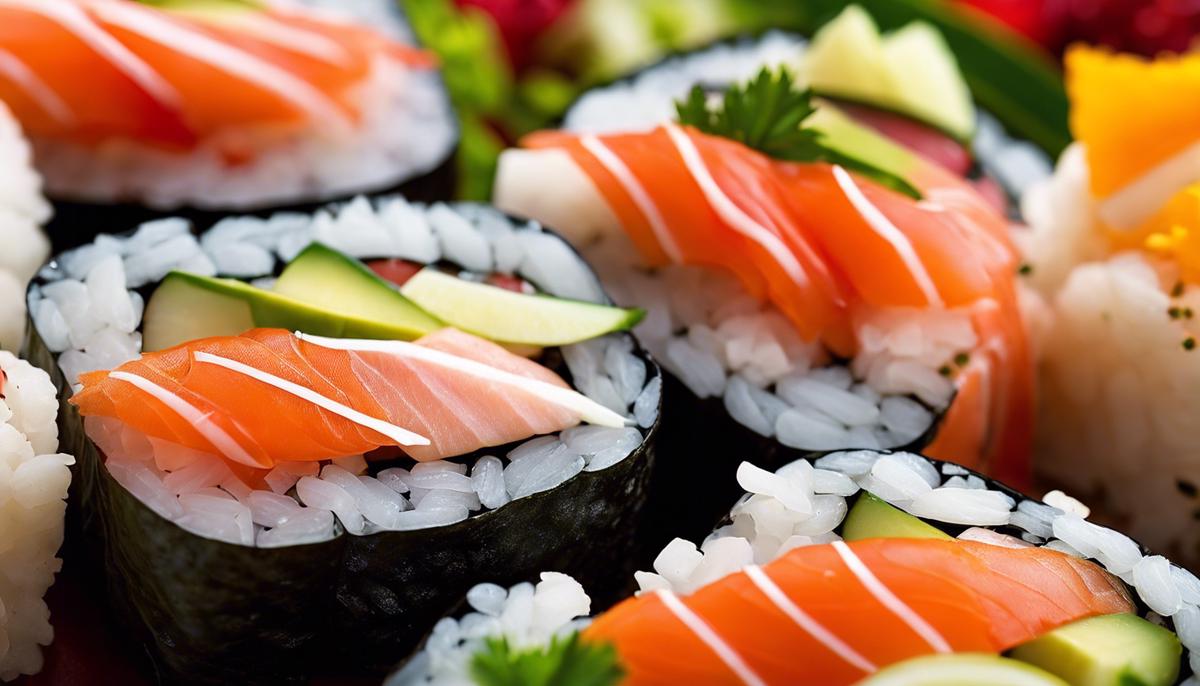
Health aspects and sustainability
Now let’s move on to an essential element of sushi creations that is the subject of this article: crab meat.
But how healthy is sushi with crab meat and what about the sustainability of this culinary delight?
The health benefits of sushi with crab meat are impressive.
Crab meat is rich in essential nutrients such as protein, vitamin B12 and selenium, all of which have a positive impact on our well-being.
Protein is the building block for muscles, while vitamin B12 and selenium support the functions of the nervous system and thyroid gland.
In addition, crab meat is low in saturated fat and contains omega-3 fatty acids, which are known to contribute to heart health.
The low-calorie nature of crab meat makes it an excellent choice for those who want to maintain or achieve a slim waistline.
Despite all the love for health, however, the idea of sustainability must not be allowed to fade into the background.
The popularity of crab meat has unfortunately also led to a rise in overfishing, raising serious concerns for the health of marine ecosystems.
When buying crab meat, it is important to pay attention to the sustainable catch.
Seals of approval such as the MSC (Marine Stewardship Council) seal ensure that the crabs have been caught according to strict environmental standards.
Vegan crab meat is another sustainable alternative.
It is usually made from konjac, a fiber-rich root, and offers an extremely authentic taste experience thanks to spices and flavorings.
Another option is sushi rolls, which are topped with local seafood such as shrimp or crayfish.
Sushi, as mentioned earlier, is a versatile food and offers ample scope for innovation and variation.
In conclusion, sushi with crab meat is a healthy and tasty option – as long as you pay attention to sustainability when buying.
Whether it’s by buying sustainably caught crab, or by choosing vegan crab meat or local alternatives, there are many ways to enjoy the pleasure of crab sushi in a responsible way.
Let us always remember that our enjoyment should not come at the expense of our oceans; because without them, this delicious delicacy would not exist.
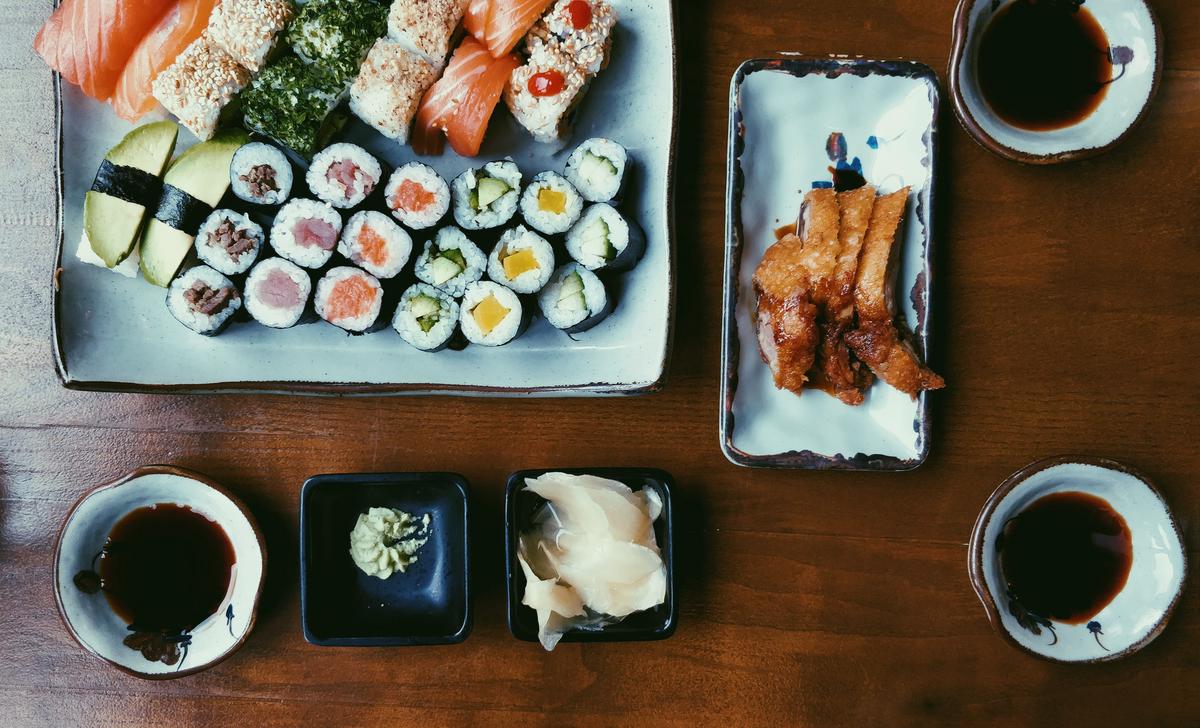
Photo by metzograf on Unsplash
Be creative with sushi recipes
Now that the history of sushi, the influence of crab meat and the change in culture, as well as the importance of sustainability, it’s time to create your own sushi adventure at home! The creative process has almost therapeutic qualities, the composition of colors and textures can almost be elevated to an art form.
At first glance, making sushi seems like a fine art, but with a little practice and tact, anyone can conquer the sushi world – including crab meat sushi. With a few simple steps, whether you use crab meat or vegan ‘crab meat’, you can create an authentic taste experience.
The first thing you need is your ingredients. In addition to the crab meat, these can include rice, seaweed, avocado, cucumber and, of course, soy sauce, ginger and wasabi. Feel free to be creative and add other ingredients as you please.
Once you have everything ready, cook the sushi rice according to the instructions and let it cool. Then place a seaweed on your sushi mat and top it with a few grains of rice, leaving a small border at the top.
Now your crab meat and whatever else you want is to be used. It is important to bring the meat into a fine processing, whether by slicing, shredding or pureeing. The crab paste is then evenly distributed over the rice along with the other ingredients.
Now it’s time for the exciting part: rolling. Hold on, lift and roll forward. Keep pressing down lightly and making sure the roll is closed. Once the roll is fixed, it can be cut into pieces. And voilà, you’ve made your own crab meat sushi using the fusion principle!
Don’t forget to show off your creation with pride. Enjoy the wonderful aromas and celebrate the art and aesthetics revealed in each piece. Surely, your DIY sushi project will evoke an uplifting feeling and your guests will admire your impressive creativity. Don’t miss out on this cultural delight and start your sushi adventure!
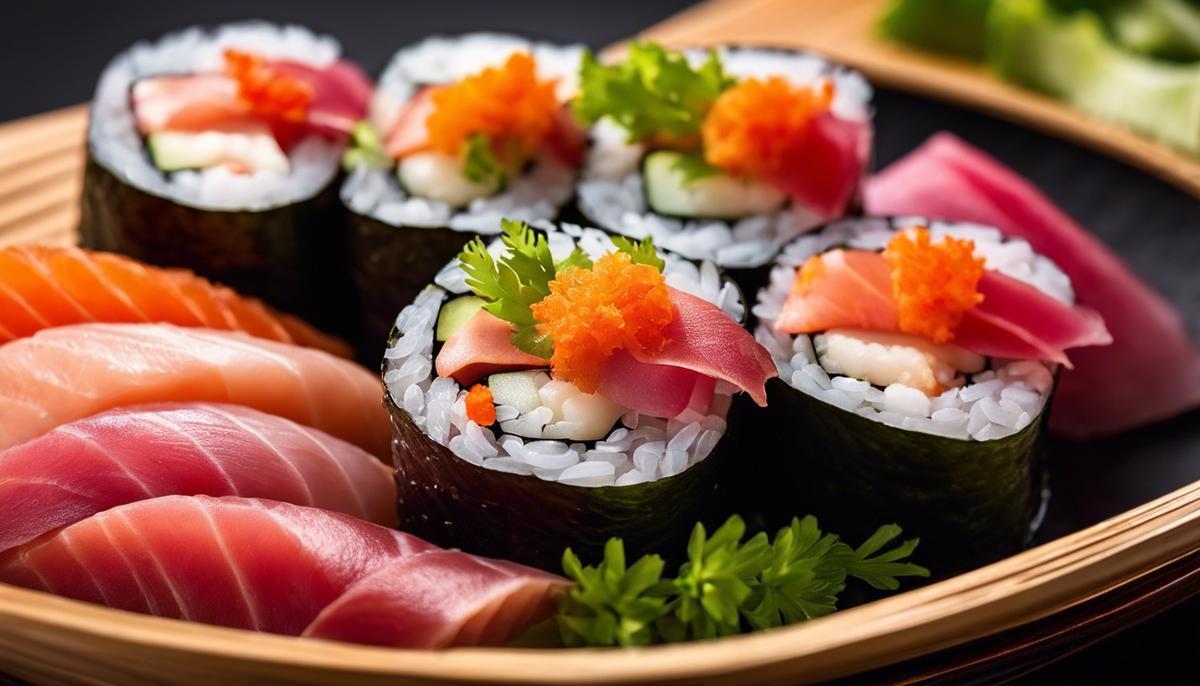
Whether you’re a sushi lover or you’ve only been on the fringes of the world of sushi until now, this detailed examination of sushi and the use of crab meat has hopefully given you an even deeper understanding and appreciation for this artful dish. With the variety, nutritional aspects, and importance of sustainability, there’s a lot to think about when it comes to sushi. But one thing is for sure – the process of preparing and enjoying a well-made sushi, whether with crab meat or any other filling, is a joy that is second to none. So why wait? Immerse yourself in the world of DIY sushi making and create your own delicious creations.
